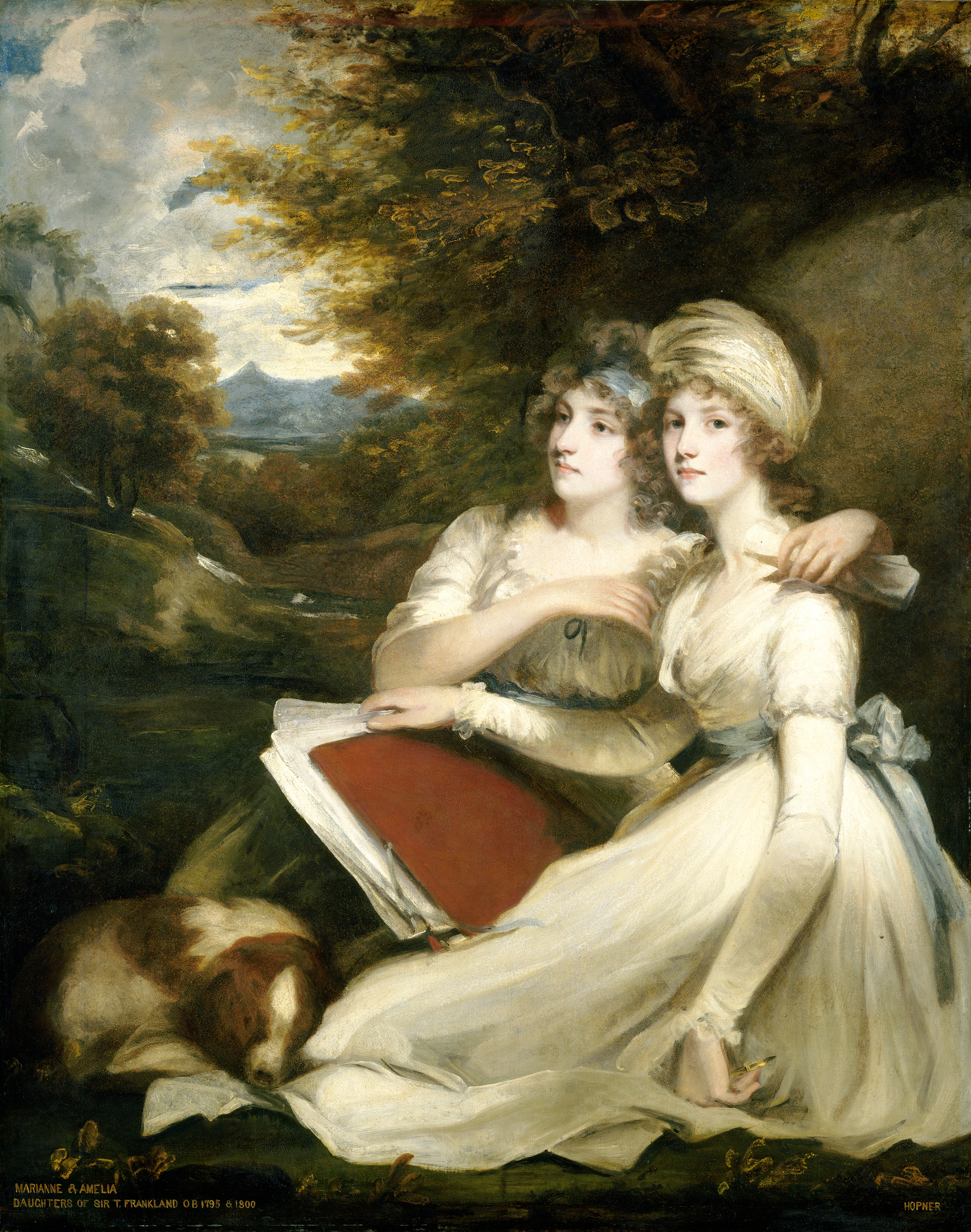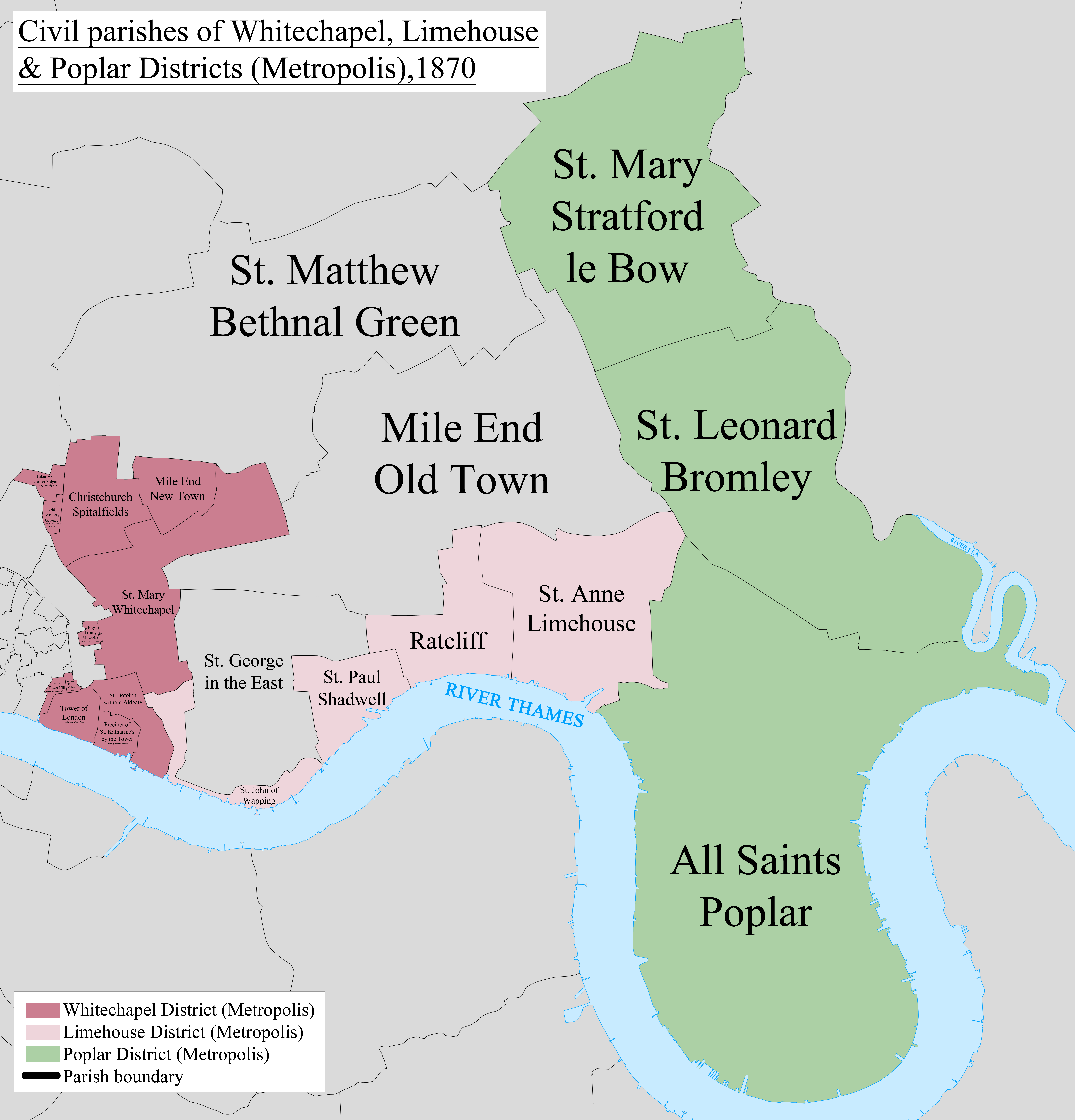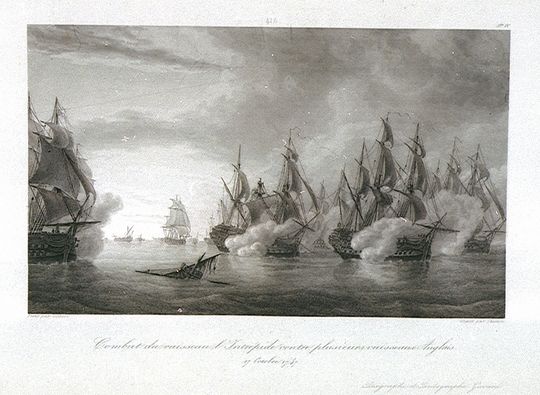|
John Hoppner
John Hoppner (4 April 175823 January 1810) was an English portrait painter, much influenced by Joshua Reynolds, who achieved fame as a colourist. Early life Hoppner was born in Whitechapel, London, the son of German parents – his mother was one of the German attendants at the royal palace. George III showed a fatherly interest and patronage of the young boy that gave rise to rumours, quite unfounded, that he may have been his illegitimate son. Hoppner became a chorister at the royal chapel, but, showing strong inclination for art, in 1775 he entered the Royal Academy. In 1778, he took a silver medal for Figure drawing, drawing from life, and in 1782 the Academy's highest award, the gold medal for historical painting, his subject being King Lear. Career Hoppner first exhibited at the Royal Academy in 1780. His earliest love was for landscape, but necessity obliged him to turn to the more lucrative business of portrait painting. At once successful, he had throughout life th ... [...More Info...] [...Related Items...] OR: [Wikipedia] [Google] [Baidu] |
Whitechapel
Whitechapel () is an area in London, England, and is located in the London Borough of Tower Hamlets. It is in east London and part of the East End of London, East End. It is the location of Tower Hamlets Town Hall and therefore the borough town centre. Whitechapel is located east of Charing Cross. The district is primarily built around Whitechapel High Street and Whitechapel Road, which extend from the City of London boundary to just east of Whitechapel station. These two streets together form a section of the originally Roman Road from the Aldgate to Colchester, a route that later became known as the ''Great Essex Road''. Population growth resulting from ribbon development along this route, led to the creation of the parish of Whitechapel, a daughter parish of Stepney#Manor and Ancient Parish, Stepney, from which it was separated, in the 14th century. Whitechapel has a long history of having a high proportion of immigrants within the community. From the late 19th century unt ... [...More Info...] [...Related Items...] OR: [Wikipedia] [Google] [Baidu] |
George Rodney, 1st Baron Rodney
Admiral George Brydges Rodney, 1st Baron Rodney, KB ( bap. 13 February 1718 – 24 May 1792), was a Royal Navy officer, politician and colonial administrator. He is best known for his commands in the American War of Independence, particularly his victory over the French at the Battle of the Saintes in 1782. It is often claimed that he was the commander to have pioneered the tactic of breaking the line. Rodney came from a distinguished but poor background, and went to sea at the age of fourteen. His first major action was the Second Battle of Cape Finisterre in 1747. He made a large amount of prize money during the 1740s, allowing him to purchase a large country estate and a seat in the House of Commons of Great Britain. During the Seven Years' War, Rodney was involved in a number of amphibious operations such as the raids on Rochefort and Le Havre and the Siege of Louisbourg. He became well known for his role in the capture of Martinique in 1762. Following the Peace of Pa ... [...More Info...] [...Related Items...] OR: [Wikipedia] [Google] [Baidu] |
Consul General
A consul is an official representative of a government who resides in a foreign country to assist and protect citizens of the consul's country, and to promote and facilitate commercial and diplomatic relations between the two countries. A consul is generally part of a government's diplomatic corps or foreign service, and thus enjoys certain privileges and protections in the host state, albeit without full diplomatic immunity. Unlike an ambassador, who serves as the single representative of one government to another, a state may appoint several consuls in a foreign nation, typically in major cities; consuls are usually tasked with providing assistance in bureaucratic issues to both citizens of their own country traveling or living abroad and to the citizens of the country in which the consul resides who wish to travel to or trade with the consul's country. Origin and history Antecedent: the classical Greek ''proxenos'' In classical Greece, some of the functions of the mo ... [...More Info...] [...Related Items...] OR: [Wikipedia] [Google] [Baidu] |
East India Company
The East India Company (EIC) was an English, and later British, joint-stock company that was founded in 1600 and dissolved in 1874. It was formed to Indian Ocean trade, trade in the Indian Ocean region, initially with the East Indies (South Asia and Southeast Asia), and later with East Asia. The company gained Company rule in India, control of large parts of the Indian subcontinent and British Hong Kong, Hong Kong. At its peak, the company was the largest corporation in the world by various measures and had its own armed forces in the form of the company's three presidency armies, totalling about 260,000 soldiers, twice the size of the British Army at certain times. Originally Chartered company, chartered as the "Governor and Company of Merchants of London Trading into the East-Indies," the company rose to account for half of the world's trade during the mid-1700s and early 1800s, particularly in basic commodities including cotton, silk, indigo dye, sugar, salt, spices, Potass ... [...More Info...] [...Related Items...] OR: [Wikipedia] [Google] [Baidu] |
Magistrate
The term magistrate is used in a variety of systems of governments and laws to refer to a civilian officer who administers the law. In ancient Rome, a '' magistratus'' was one of the highest ranking government officers, and possessed both judicial and executive powers. In other parts of the world, such as China, magistrate is a word applied to a person responsible for administration over a particular geographic area. Today, in some jurisdictions, a magistrate is a judicial officer who hears cases in a lower court, and typically deals with more minor or preliminary matters. In other jurisdictions (e.g., England and Wales), magistrates are typically trained volunteers appointed to deal with criminal and civil matters in their local areas. Original meaning In ancient Rome, the word '' magistratus'' referred to one of the highest offices of state. Analogous offices in the local authorities, such as '' municipium'', were subordinate only to the legislature of which they generally ... [...More Info...] [...Related Items...] OR: [Wikipedia] [Google] [Baidu] |
Patience Wright
Patience Wright (born Lovell; 1725 – March 23, 1786) was a sculptor of wax figures, and the first recognized American-born sculptor. Wright is recorded as creating at least 55 works; only her full-length figure of Lord Chatham (William Pitt) survives. Biography Early life Patience Lovell was born at Oyster Bay, New York, into a Quaker farm family with a vegetarian diet. The family moved to Bordentown, New Jersey, when Patience was four years old. The Madame Tussaud of the American Colonies Was A Founding Fathers Stalker, Smithsonian.com Weekly Newsletter (29 December 2013) At age 16, she left the family home and moved to [...More Info...] [...Related Items...] OR: [Wikipedia] [Google] [Baidu] |
Dunedin Public Art Gallery
The Dunedin Public Art Gallery holds the main public art collection of the city of Dunedin, New Zealand. Located in The Octagon in the heart of the city, it is close to the city's public library, Dunedin Town Hall, and other facilities such as the Regent Theatre. History The gallery was founded by W. M. Hodgkins in 1884 and was the first public art gallery in New Zealand. It originally occupied what is now the maritime gallery in the Otago Museum, was re-located to the Municipal Chambers in the Octagon from 1888–90, and then to an annex to the Otago Museum. It moved to a new purpose-designed building in Queen's Gardens in 1907, to which a structure housing the Otago Settlers Museum was added the following year. In 1927 it was moved to a building constructed for the 1925–26 New Zealand and South Seas International Exhibition in Logan Park, Dunedin North designed by Edmund Anscombe. The building was bought and donated to the city by Sir Percy and Lady Sargood, ... [...More Info...] [...Related Items...] OR: [Wikipedia] [Google] [Baidu] |
Thomas Gainsborough
Thomas Gainsborough (; 14 May 1727 (baptised) – 2 August 1788) was an English portrait and landscape painter, draughtsman, and printmaker. Along with his rival Sir Joshua Reynolds, he is considered one of the most important British artists of the second half of the 18th century. He painted quickly, and the works of his maturity are characterised by a light palette and easy strokes. Despite being a prolific portrait painter, Gainsborough gained greater satisfaction from his landscapes. He is credited (with Richard Wilson (painter), Richard Wilson) as the originator of the 18th-century British landscape school. Gainsborough was a founding member of the Royal Academy of Arts, Royal Academy. Youth and training Gainsborough was born in Sudbury, Suffolk, Sudbury, Suffolk, the youngest son of John Gainsborough, a weaver and maker of woollen goods, and his wife Mary, sister of the Reverend Humphry Burroughs. One of Gainsborough's brothers, Humphrey Gainsborough, Humphrey, is said t ... [...More Info...] [...Related Items...] OR: [Wikipedia] [Google] [Baidu] |
Charlotte, Countess Talbot
John Talbot, 1st Earl Talbot (25 February 1749 – 19 May 1793), known as John Talbot until 1782 and as The Lord Talbot between 1782 and 1784, was a British peer and politician. Background A member of Talbot family headed by the Earl of Shrewsbury, Talbot was the son of John Talbot (judge), John Talbot, younger son of Charles Talbot, 1st Baron Talbot, and his wife Catherine, daughter of John Chetwynd, 2nd Viscount Chetwynd. Political career Talbot was returned to Parliament for Castle Rising (UK Parliament constituency), Castle Rising in 1777, a seat he held until 1782, when he succeeded his uncle, William Talbot, 1st Earl Talbot, as third Baron Talbot and entered the House of Lords. In 1784 the earldom of Talbot which had become extinct on his uncle's death was revived when Talbot was created Viscount of Ingestre, in the County of Stafford, and Earl Talbot, of Hensol in the County of Glamorgan. Two years later he assumed by Royal licence the additional surname and arms of C ... [...More Info...] [...Related Items...] OR: [Wikipedia] [Google] [Baidu] |
Encyclopædia Britannica
The is a general knowledge, general-knowledge English-language encyclopaedia. It has been published by Encyclopædia Britannica, Inc. since 1768, although the company has changed ownership seven times. The 2010 version of the 15th edition, which spans 32 volumes and 32,640 pages, was the last printed edition. Since 2016, it has been published exclusively as an online encyclopedia, online encyclopaedia. Printed for 244 years, the ''Britannica'' was the longest-running in-print encyclopaedia in the English language. It was first published between 1768 and 1771 in Edinburgh, Scotland, in three volumes. The encyclopaedia grew in size; the second edition was 10 volumes, and by its fourth edition (1801–1810), it had expanded to 20 volumes. Its rising stature as a scholarly work helped recruit eminent contributors, and the 9th (1875–1889) and Encyclopædia Britannica Eleventh Edition, 11th editions (1911) are landmark encyclopaedias for scholarship and literary ... [...More Info...] [...Related Items...] OR: [Wikipedia] [Google] [Baidu] |
Sir George Beaumont, 7th Baronet
Sir George Howland Beaumont, 7th Baronet (6 November 1753 – 7 February 1827) was a British art patron and amateur painter. He played a crucial part in the creation of London's National Gallery by making the first bequest of paintings to that institution. Biography Born in Great Dunmow, Essex, he was the only surviving child of the landowner Sir George Beaumont, 6th Baronet, from whom he inherited the baronetcy in 1762 (see Beaumont baronets) and Rachel ee Howlanddaughter of Michael Howland of Stone Hall, Matching Green. Beaumont was educated at Eton College, where he was taught drawing by the landscape painter Alexander Cozens. The first paintings to enter Beaumont's collection were by artists he knew, but a Grand Tour which he undertook in 1782 with his wife Margaret (the daughter of John Willes M.P., of Astrop, Oxon and granddaughter of Sir John Willes M.P., Chief Justice of the Court of Common Pleas) widened his taste to include the Old Masters. On his return he ... [...More Info...] [...Related Items...] OR: [Wikipedia] [Google] [Baidu] |
Henry Bartle Frere
Sir Henry Bartle Edward Frere, 1st Baronet, (29 March 1815 – 29 May 1884) was a British Empire, British colonial administrator. He had a successful career in British Raj, India, rising to become Governor of Bombay (1862–1867). However, as High Commissioner for Southern Africa (1877–1880), he implemented a set of policies which attempted to impose a British confederation on the region and which led to the overthrow of the Cape Colony's John Charles Molteno, first elected government in 1878 and to a string of regional wars, culminating in the Anglo-Zulu War, invasion of Zululand (1879) and the First Boer War (1880–1881). The Prime Minister of the United Kingdom, British Prime Minister, William Ewart Gladstone, Gladstone, recalled Frere to London to face charges of misconduct; Whitehall officially censured Frere for acting recklessly. Early life Frere was born at Clydach House, Llanelly, Clydach House, Clydach, Monmouthshire, the son of Edward Frere, manager of Clydac ... [...More Info...] [...Related Items...] OR: [Wikipedia] [Google] [Baidu] |









